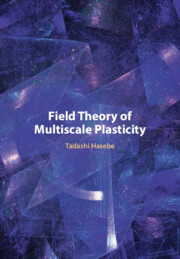Book contents
- Field Theory of Multiscale Plasticity
- Field Theory of Multiscale Plasticity
- Copyright page
- Contents
- Preface
- Acknowledgments
- Part I Fundamentals
- Part II Theoretical Backgrounds
- Part III Applications I
- 9 Identification of Important Scales
- 10 Scale A: Modeling and Simulations for Dislocation Substructures
- 11 Scale B
- 12 Scale C
- Part IV Applications II
- References
- Author Index
- Subject Index
12 - Scale C
Modeling and Simulations for Polycrystalline Aggregate
from Part III - Applications I
Published online by Cambridge University Press: 14 December 2023
- Field Theory of Multiscale Plasticity
- Field Theory of Multiscale Plasticity
- Copyright page
- Contents
- Preface
- Acknowledgments
- Part I Fundamentals
- Part II Theoretical Backgrounds
- Part III Applications I
- 9 Identification of Important Scales
- 10 Scale A: Modeling and Simulations for Dislocation Substructures
- 11 Scale B
- 12 Scale C
- Part IV Applications II
- References
- Author Index
- Subject Index
Summary
Until quite recently, discussions on “polycrystals” have been rather concentrated on or confined to how to realistically evaluate the averaged (macroscopic) stress-strain response, focusing on, e.g., relaxed constraint even with FEM simulations. This chapter discusses new perspectives related to Scale C and the attendant theory and modeling for polycrystalline materials including nanocrystals based on the field theory (they mostly are the latest achievements). Emphasis here is placed on the collective effects brought about by a large number of composing grains on the meso- and macroscopic deformation behavior of polycrystals, in the context of hierarchy of polycrystalline plasticity. For this purpose, a series of systematically designed finite element simulations have been conducted.
- Type
- Chapter
- Information
- Field Theory of Multiscale Plasticity , pp. 604 - 678Publisher: Cambridge University PressPrint publication year: 2024

